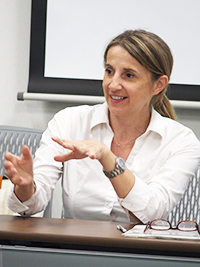 The IGS Seminar, “The Size of History: Small Worlds, Big Worlds, and the People Caught in Between,” featuring a lecture by Dr. Laura Nenzi (Specially Appointed Professor, IGS/Professor, The University of Tennessee), was held on July 18, 2017. Nenzi’s research focuses on Tokugawa social and cultural history with a particular interest in gender. The lecture was structured in response to the question “Is there a ‘right size’ of history?” Beginning with her book, The Chaos and Cosmos of Kurosawa Tokiko, Nenzi explained the methodology of conducting a microhistory.
The IGS Seminar, “The Size of History: Small Worlds, Big Worlds, and the People Caught in Between,” featuring a lecture by Dr. Laura Nenzi (Specially Appointed Professor, IGS/Professor, The University of Tennessee), was held on July 18, 2017. Nenzi’s research focuses on Tokugawa social and cultural history with a particular interest in gender. The lecture was structured in response to the question “Is there a ‘right size’ of history?” Beginning with her book, The Chaos and Cosmos of Kurosawa Tokiko, Nenzi explained the methodology of conducting a microhistory.
The book’s main character, Tokiko Kurosawa (1806–1890), was a woman who lived during a time of radical social change from the end of Edo to the Meiji period,  and spent most of her life in a small Suzugoya village in the Mito domain (present day Shirosato Town, Ibaraki Prefecture). Kurosawa was committed to various activities as a teacher, a poet, an oracle, and a political activist. However, Kurosawa is not the kind of person whose name is usually found in history textbooks, and “microhistory” is a mode of research that highlights on a seemingly insignificant existence, such as that of Tokiko Kurosawa.
and spent most of her life in a small Suzugoya village in the Mito domain (present day Shirosato Town, Ibaraki Prefecture). Kurosawa was committed to various activities as a teacher, a poet, an oracle, and a political activist. However, Kurosawa is not the kind of person whose name is usually found in history textbooks, and “microhistory” is a mode of research that highlights on a seemingly insignificant existence, such as that of Tokiko Kurosawa.
Conventional history writing tends to discuss famous historical actors, certain period divisions, and large cities. In contrast, microhistory focuses on insignificant and unknown people, relatively short periods, and small towns and rural villages. This contrast can be explained using metaphors, such as panorama and close-up, a tree and a leaf, a frog and its skin cell, and an open green field and a ladybird. Nenzi stressed that because microhistory researches such insignificant people and incidents, it makes the justification of the research more important.
Research methods on a larger scale are explained when tracing the history of studies on history in the US. From the early 18th century to the early 19th century, “the History of Western Civilization” was the mainstream form of historical research. Due to social insecurity caused by massive immigration and the First World War, the US society experienced an identity crisis. This social condition demanded a definition of “the West” to which history education responded. At that time, a linear development model was employed and the West was defined as the highest among all civilizations. By the beginning of the 1970s, the Civil Rights movement brought the rise of the concept of “World History.” With the acknowledgment of the differences among nations, the superior/inferior distinction was dropped and the idea of linear development was rejected, although the notion of the national border was kept to mark geographical frames. During the 1990s, the concept of “Global History” emerged and the perspective it offered, beyond existing geopolitical borders, helped to produce research on trans-border migration and new geographical frames such as Eurasia. Some historians are building an even larger history, “Big History,” which sets its starting point at the Big Bang and examines history at a cosmic scale.
After listing the various sizes at which historical research is conducted, Nenzi asked the audience a question: “Which size is correct?” The lecturer answered that there is no need to choose or stick to one size. Changing the size of history means changing perspective. For example, microhistory is not just about magnifying small incidents. The perspective of microhistory is more like gazing into the distance through a keyhole. Linking the lives of ordinary people to a larger historical movement helps us to gain knowledge about people living in a certain era and to deepen our historical understanding.
Although the main theme of the lecture was the methodology of history studies, the audience comprised researchers from different disciplines. The advantage of changing perspectives may be common among various academic disciplines, and listening to a lecture focused on changing perspectives from the viewpoint of the discipline of history may have helped the audience to reconsider their positions. Nenzi also stressed that the method of microhistory is advantageous for research on history through a gender perspective. The lecture provided a good opportunity to rethink the methodology of gender studies.

